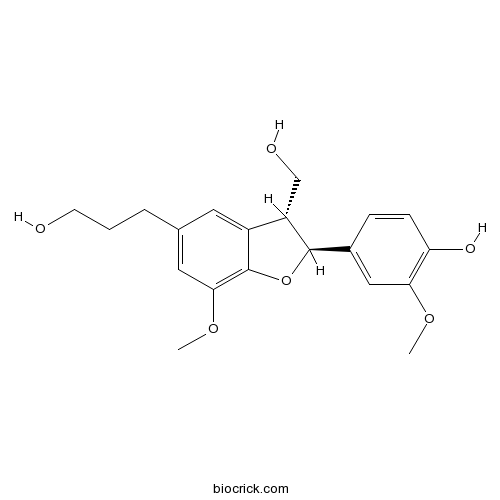Dihydrodehydrodiconiferyl alcoholCAS# 28199-69-1 |

- (2R,3S)-Dihydrodehydroconiferyl alcohol
Catalog No.:BCN7886
CAS No.:126253-41-6
Quality Control & MSDS
3D structure
Package In Stock
Number of papers citing our products

| Cas No. | 28199-69-1 | SDF | Download SDF |
| PubChem ID | 384679 | Appearance | Powder |
| Formula | C20H24O6 | M.Wt | 360.4 |
| Type of Compound | Lignans | Storage | Desiccate at -20°C |
| Solubility | Soluble in Chloroform,Dichloromethane,Ethyl Acetate,DMSO,Acetone,etc. | ||
| Chemical Name | 4-[(2S,3R)-3-(hydroxymethyl)-5-(3-hydroxypropyl)-7-methoxy-2,3-dihydro-1-benzofuran-2-yl]-2-methoxyphenol | ||
| SMILES | COC1=C(C=CC(=C1)C2C(C3=CC(=CC(=C3O2)OC)CCCO)CO)O | ||
| Standard InChIKey | SBLZVJIHPWRSQQ-HNAYVOBHSA-N | ||
| Standard InChI | InChI=1S/C20H24O6/c1-24-17-10-13(5-6-16(17)23)19-15(11-22)14-8-12(4-3-7-21)9-18(25-2)20(14)26-19/h5-6,8-10,15,19,21-23H,3-4,7,11H2,1-2H3/t15-,19+/m0/s1 | ||
| General tips | For obtaining a higher solubility , please warm the tube at 37 ℃ and shake it in the ultrasonic bath for a while.Stock solution can be stored below -20℃ for several months. We recommend that you prepare and use the solution on the same day. However, if the test schedule requires, the stock solutions can be prepared in advance, and the stock solution must be sealed and stored below -20℃. In general, the stock solution can be kept for several months. Before use, we recommend that you leave the vial at room temperature for at least an hour before opening it. |
||
| About Packaging | 1. The packaging of the product may be reversed during transportation, cause the high purity compounds to adhere to the neck or cap of the vial.Take the vail out of its packaging and shake gently until the compounds fall to the bottom of the vial. 2. For liquid products, please centrifuge at 500xg to gather the liquid to the bottom of the vial. 3. Try to avoid loss or contamination during the experiment. |
||
| Shipping Condition | Packaging according to customer requirements(5mg, 10mg, 20mg and more). Ship via FedEx, DHL, UPS, EMS or other couriers with RT, or blue ice upon request. | ||
| Description | 1. Dihydrodehydrodiconiferyl alcohol may be useful candidates for developing therapeutic agents for the prevention and treatment of hepatic fibrosis. 2. Dihydrodehydrodiconiferyl alcohol exhibits in vitro cytotoxicity in various cancer cell lines. |
| Targets | TNF-α |

Dihydrodehydrodiconiferyl alcohol Dilution Calculator

Dihydrodehydrodiconiferyl alcohol Molarity Calculator
| 1 mg | 5 mg | 10 mg | 20 mg | 25 mg | |
| 1 mM | 2.7747 mL | 13.8735 mL | 27.7469 mL | 55.4939 mL | 69.3674 mL |
| 5 mM | 0.5549 mL | 2.7747 mL | 5.5494 mL | 11.0988 mL | 13.8735 mL |
| 10 mM | 0.2775 mL | 1.3873 mL | 2.7747 mL | 5.5494 mL | 6.9367 mL |
| 50 mM | 0.0555 mL | 0.2775 mL | 0.5549 mL | 1.1099 mL | 1.3873 mL |
| 100 mM | 0.0277 mL | 0.1387 mL | 0.2775 mL | 0.5549 mL | 0.6937 mL |
| * Note: If you are in the process of experiment, it's necessary to make the dilution ratios of the samples. The dilution data above is only for reference. Normally, it's can get a better solubility within lower of Concentrations. | |||||

Calcutta University

University of Minnesota

University of Maryland School of Medicine

University of Illinois at Chicago

The Ohio State University

University of Zurich

Harvard University

Colorado State University

Auburn University

Yale University

Worcester Polytechnic Institute

Washington State University

Stanford University

University of Leipzig

Universidade da Beira Interior

The Institute of Cancer Research

Heidelberg University

University of Amsterdam

University of Auckland

TsingHua University

The University of Michigan

Miami University

DRURY University

Jilin University

Fudan University

Wuhan University

Sun Yat-sen University

Universite de Paris

Deemed University

Auckland University

The University of Tokyo

Korea University
- Sinensin
Catalog No.:BCN4797
CAS No.:28189-90-4
- 5-Amino-2-mercaptobenzimidazole
Catalog No.:BCC8730
CAS No.:2818-66-8
- Futoquinol
Catalog No.:BCN6416
CAS No.:28178-92-9
- CHC
Catalog No.:BCC7994
CAS No.:28166-41-8
- Peonidin-3-O-galactoside chloride
Catalog No.:BCN3027
CAS No.:28148-89-2
- 8-Aminoadenine
Catalog No.:BCC6108
CAS No.:28128-33-8
- H-Pro-OtBu
Catalog No.:BCC3020
CAS No.:2812-46-6
- Pluviatolide
Catalog No.:BCN3041
CAS No.:28115-68-6
- Adamantane
Catalog No.:BCN8481
CAS No.:281-23-2
- Chaetocin
Catalog No.:BCC2429
CAS No.:28097-03-2
- (+)-Ulopterol
Catalog No.:BCN1228
CAS No.:28095-18-3
- A 286982
Catalog No.:BCC3946
CAS No.:280749-17-9
- Lauterine
Catalog No.:BCN7062
CAS No.:28200-65-9
- JTE 907
Catalog No.:BCC7380
CAS No.:282089-49-0
- Phlorin
Catalog No.:BCN5177
CAS No.:28217-60-9
- HOOBt
Catalog No.:BCC2817
CAS No.:28230-32-2
- Reynosin
Catalog No.:BCN5178
CAS No.:28254-53-7
- Tyrphostin A1
Catalog No.:BCC5404
CAS No.:2826-26-8
- Baicalein 6-O-glucoside
Catalog No.:BCN3325
CAS No.:28279-72-3
- Beta-Elemonic acid
Catalog No.:BCN2981
CAS No.:28282-25-9
- Daurinoline
Catalog No.:BCN2742
CAS No.:2831-75-6
- 5-Hydroxy-1-tetralone
Catalog No.:BCN8397
CAS No.:28315-93-7
- Valifenalate
Catalog No.:BCC8071
CAS No.:283159-90-0
- Fmoc-ß-HoAsn(Trt)-OH
Catalog No.:BCC3228
CAS No.:283160-20-3
Antifibrotic compounds from Liriodendron tulipifera attenuating HSC-T6 proliferation and TNF-alpha production in RAW264.7 cells.[Pubmed:25747981]
Biol Pharm Bull. 2015;38(2):228-34.
The inhibition of hepatic stellate cell (HSC) proliferation has been considered as an effective therapeutic target for the treatment of liver fibrosis. The methanolic extract of Liriodendron tulipifera showed significant inhibitory activity against the proliferation of HSCs. Bioactivity-guided isolation afforded twelve compounds including (-)-sesamin (1), (-)-syringaresinol (2), (+)-Dihydrodehydrodiconiferyl alcohol (3), salvinal (4), (+)-guaiacylglycerol-8-O-4'-dihydroconiferyl ether (5), (+/-)-guaiacylglycerol-8-O-4'-sinapyl alcohol ether (6), tanegool (7), (+)-5,5'-dimethoxy-7-oxolariciresinol (8), 3-hydroxy-4-methoxyacetophenone (9), 4-acetoxymethylphenol (10), (-)-paramicholide (11), and blumenol A (12). Among the compounds isolated, 2, 3 and 4 significantly attenuated the proliferation of the activated HSC-T6 cells. The maximal dose of these compounds, however, showed no cytotoxicity in primary cultured rat hepatocytes. Collagen deposition in the activated HSC-T6 cells was reduced by 2, 3 and 4. Also, the increased production of the pro-inflammatory cytokine tumor necrosis factor (TNF)-alpha induced by lipopolysaccharide was decreased by 3 and 4 in RAW264.7 macrophage cells. Collectively, (-)-syringaresinol (2), (+)-Dihydrodehydrodiconiferyl alcohol (3), and salvinal (4) isolated from L. tulipifera leaves and twigs exhibited selective antifibrotic activities toward the activated HSCs and suppressed TNF-alpha production in RAW264.7 macrophages. These compounds may be useful candidates for developing therapeutic agents for the prevention and treatment of hepatic fibrosis.


